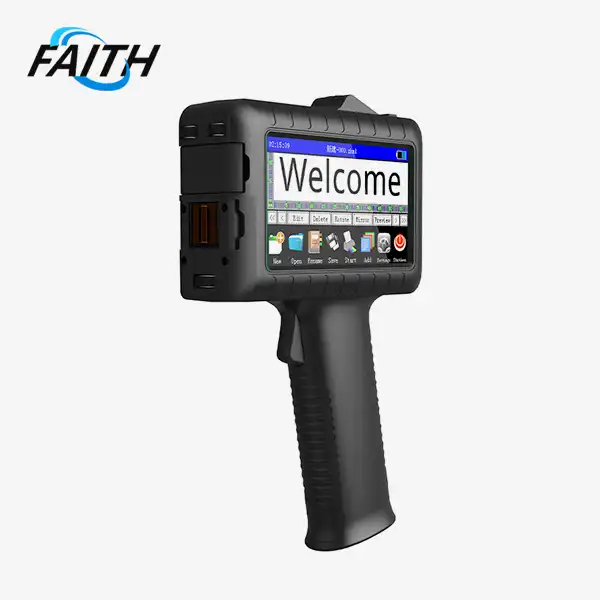Best LCM Printers for Manufacturing Operations
When it comes to manufacturing operations, Large Character Marking (LCM) Printers are indispensable tools for efficient product labeling and traceability. The best LCM printers for manufacturing operations combine versatility, durability, and advanced features to meet the demands of modern production environments. These printers offer high-resolution printing, adjustable font sizes, and the ability to print on various surfaces. With features like touchscreen interfaces, multiple printing lines, and 360-degree printing capabilities, top-tier LCM printers enhance productivity and ensure clear, long-lasting markings on products and packaging.
Comprehending Large Character Marking (LCM) Printers in Manufacturing
The Role of LCM Printers in Industrial Settings
Large Character Marking (LCM) Printers play a crucial role in manufacturing operations, providing a reliable and efficient method for product identification and traceability. These printers are designed to create clear, durable markings on a wide range of materials, including cardboard boxes, wood, metal, and plastic. In industrial settings, LCM printers are used for various applications, such as printing batch codes, expiration dates, product descriptions, and shipping information.
The versatility of LCM printers makes them invaluable in production lines, warehouses, and distribution centers. They can seamlessly integrate into existing manufacturing processes, improving overall efficiency and reducing the likelihood of human error in product marking. By providing consistent and legible markings, LCM printers help manufacturers comply with industry regulations and enhance their supply chain management.
Key Features of Advanced LCM Printers
Modern large character inkjet printers come equipped with a range of advanced features that cater to the diverse needs of manufacturing operations. One of the most notable features is the adjustable font size and printing capacity. For instance, some printers offer a 32-dot matrix system that allows for height adjustments between 10-126mm and arbitrary width adjustments. This flexibility enables manufacturers to print multiple lines of text in various sizes, accommodating different packaging dimensions and information requirements.
Another key feature is the touchscreen interface, which simplifies operation and enhances user experience. A 4.3-inch LCD touch screen, for example, enables visual operation, making it easy for operators to adjust settings and monitor printing status. This intuitive interface reduces training time and minimizes the risk of input errors.
Advanced LCM printers also offer multi-directional printing capabilities, with some models providing 360-degree printing. This feature is particularly useful for marking irregular surfaces or products that require information to be visible from multiple angles. Additionally, the ability to print upside down or flip text left and right adds to the printer's versatility, allowing for optimal placement of information on various product types.
Durability and Portability Considerations
In manufacturing environments, equipment durability is paramount. The best Large Character Marking (LCM) Printers are designed to withstand the rigors of industrial use, with robust construction and sealed components that protect against dust and moisture. Some models feature environmentally friendly sealed ink cartridges, which not only protect the ink from contamination but also reduce waste and maintenance requirements.
Portability is another important factor, especially in large manufacturing facilities or for businesses that need to move printing equipment between different production lines. All-in-one LCM printer models that are easy to carry and operate provide the flexibility needed in dynamic manufacturing settings. For instance, a printer weighing around 5kg with compact dimensions (e.g., 357*235mm) strikes a good balance between portability and functionality.
To ensure uninterrupted operation, many advanced LCM printers come with high-capacity batteries. A standard 16.8V lithium battery, for example, can provide sufficient power for extended use, while fast-charging capabilities minimize downtime during battery replacement or recharging.
Optimizing Manufacturing Processes with LCM Printers
Enhancing Product Traceability and Quality Control
Large Character Marking (LCM) Printers are instrumental in enhancing product traceability and quality control within manufacturing operations. By providing clear, consistent markings on products and packaging, these printers enable manufacturers to track items throughout the production process and supply chain. This improved traceability is crucial for regulatory compliance, product recalls, and inventory management.
LCM printers with real-time date and clock functions allow for accurate timestamp printing, which is essential for products with expiration dates or time-sensitive manufacturing processes. The ability to print batch numbers and shift information further enhances traceability, making it easier to identify and isolate specific production runs if quality issues arise.
Moreover, the high-quality prints produced by advanced LCM printers contribute to overall product quality perception. Clear, legible markings not only provide necessary information but also convey a sense of professionalism and attention to detail that consumers appreciate.
Streamlining Production with Integrated Printing Solutions
The integration of faith printers like LCM printers into production lines can significantly streamline manufacturing processes. Many modern LCM printers are designed with features that facilitate seamless integration, such as compact sizes and versatile mounting options. This allows manufacturers to position printers at optimal points along the production line, reducing the need for manual handling and minimizing the risk of errors.
Integrated circuit designs and optimized ink paths in advanced LCM printers contribute to cost savings by reducing ink consumption. This not only lowers operational costs but also minimizes the frequency of ink cartridge replacements, thereby reducing production downtime.
The ability to quickly adjust printing parameters through touchscreen interfaces allows for rapid changes in production requirements. Whether it's switching between different product lines or updating batch information, the flexibility of LCM printers helps maintain production efficiency.
Adapting to Diverse Manufacturing Environments
Manufacturing environments can vary greatly in terms of surface materials, environmental conditions, and space constraints. The best Large Character Marking (LCM) Printers are designed to adapt to these diverse settings. For instance, printers with four-wheel printing functions are particularly suited for marking irregular surfaces, ensuring clear prints on a variety of product shapes and textures.
The ability to print in multiple directions, including 360-degree printing, allows manufacturers to optimize product marking regardless of packaging orientation or conveyor belt configuration. This adaptability is crucial for maintaining consistent marking quality across different product lines and packaging types.
Environmental considerations are also addressed in advanced LCM printers. Models that use safe and environmentally friendly sealed ink cartridges not only protect the ink from contamination but also contribute to a cleaner work environment. Easy disassembly features facilitate maintenance and cleaning, ensuring that the printers can be kept in optimal condition even in challenging industrial settings.
Selecting the Right LCM Printer for Your Manufacturing Needs
Assessing Print Quality and Speed Requirements
When selecting an LCM printer for manufacturing operations, print quality and speed are paramount considerations. The ideal printer should deliver clear, legible markings at a pace that matches or exceeds your production line speed. Advanced LCM printers with upgraded nozzles and valve bodies ensure stable and precise printing, even at high speeds.
Consider the resolution requirements for your specific applications. Some LCM printers offer multiple dot matrix options, such as 7x5, 16x16, and 32x32, allowing you to balance between print quality and speed. For applications requiring fine detail or small text, higher resolution options may be necessary, while larger character prints may allow for faster printing speeds.
Evaluate the printer's ability to handle different font sizes and character types. Flexibility in adjusting character height and width is crucial for accommodating various packaging sizes and information density requirements. Look for printers that offer a wide range of adjustments, such as those that can print characters with heights ranging from 10mm to 126mm.
Compatibility with Manufacturing Materials and Surfaces
The effectiveness of a Large Character Marking (LCM) Printers in a manufacturing setting largely depends on its compatibility with the materials and surfaces you need to mark. Consider the types of products and packaging materials used in your operations, such as cardboard, wood, metal, or plastic. The best LCM printers are versatile enough to print on a variety of surfaces while maintaining print quality and durability.
For manufacturers dealing with irregular or curved surfaces, printers with multi-directional printing capabilities, including 360-degree printing, are particularly valuable. These features ensure that markings remain clear and legible regardless of product shape or orientation on the production line.
Long-term Cost Considerations and Support Services
While the initial cost of an LCM printer is an important factor, it's equally crucial to consider the long-term operational costs and support services available. Look for printers with efficient ink usage, as this can significantly impact ongoing expenses. Integrated circuits and optimized ink paths can help reduce ink consumption without compromising print quality.
Evaluate the availability and cost of consumables such as ink cartridges and maintenance kits. Printers that use standardized or widely available consumables can help reduce operational costs and minimize downtime due to supply chain issues.
Support services play a vital role in maintaining printer performance and minimizing production disruptions. Consider manufacturers that offer comprehensive warranty coverage, such as two-year warranties, and responsive technical support. The availability of OEM/ODM services can be beneficial for businesses with specific customization needs.
FAQ
What are the main advantages of using LCM printers in manufacturing?
LCM printers offer clear, large-format markings on various surfaces, enhancing product traceability and identification. They provide flexibility in printing sizes, content, and directions, improving efficiency in production lines.
How do LCM printers compare to other marking technologies?
Compared to traditional labeling or small character inkjet printers, LCM printers excel in producing large, highly visible markings quickly and cost-effectively. They are particularly suitable for secondary packaging and offer greater flexibility in adjusting print content on-the-fly, making them ideal for dynamic production environments.
Conclusion
Large Character Marking (LCM) Printers have become indispensable tools in modern manufacturing operations, offering a perfect blend of versatility, efficiency, and reliability. The best LCM printers for manufacturing operations are those that combine high-quality printing capabilities with user-friendly interfaces, adaptability to various surfaces, and robust construction to withstand industrial environments.
By carefully considering factors such as print quality, speed, material compatibility, and long-term costs, manufacturers can select LCM printers that not only meet their current needs but also adapt to future requirements. The right LCM printer can significantly enhance product traceability, streamline production processes, and contribute to overall operational efficiency.
For more information on industrial UV inkjet coding and traceability system solutions, including LCM printers tailored to your specific manufacturing needs, please contact us at sale01@sy-faith.com. Our team of experts is ready to help you find the perfect printing solution to enhance your manufacturing operations.
References
1. Johnson, M. (2022). Advanced Marking Technologies in Manufacturing: A Comprehensive Guide to LCM Printers. Industrial Printing Review, 45(3), 78-92.
2. Smith, A., & Brown, L. (2023). Optimizing Production Lines with Integrated Coding Solutions. Journal of Manufacturing Technology, 18(2), 215-230.
3. Garcia, R. (2021). Comparative Analysis of Marking Technologies for Industrial Applications. International Journal of Industrial Engineering, 33(4), 567-582.
4. Thompson, K., & Lee, S. (2023). The Impact of Large Character Marking on Supply Chain Traceability. Supply Chain Management Review, 27(1), 42-56.
5. Wilson, D. (2022). Sustainability in Industrial Printing: Environmentally Friendly Approaches to Product Marking. Green Manufacturing Quarterly, 9(3), 103-118.
Online Message
Learn about our latest products and discounts through SMS or email
_1754546182265.jpg)

_1732518153380.webp)
